|
|
|
HOME
|
US Navy -
ships
|
US Navy - air
units
|
USMC - air
units
|
International
Navies
|
Weapon Systems
|
Special Reports |
|
Royal New Zealand Navy Anzac class Frigate (FFH) |
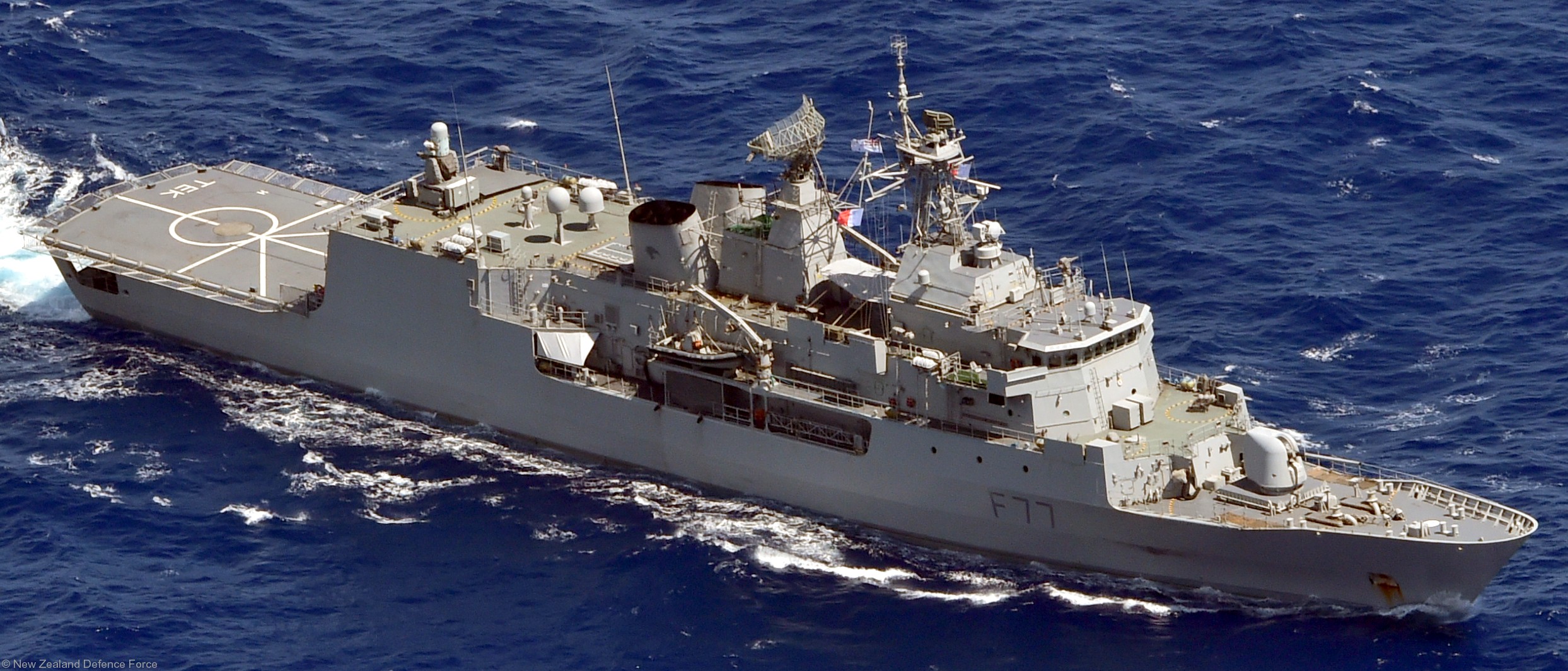 |
| 11/23 |
| Ships: |
|
F 77 HMNZS Te Kaha (1997) F 111 HMNZS Te Mana (1999) |
| Specifications: |
|
Builder: Tenix Defence, Williamstown, Australia Displacement: 3600 tons (full load) Length: 118 meters (387 feet) overall Beam: 14.8 meters (49 ft) Draft: 6.2 meters (20.3 ft) Speed: 27+ knots (50 km/h) Range: 6000 NM (11000 km) at 18 knots (33 km/h) Complement: 178 + 10 aircrew Propulsion: CODOG (Combined Diesel or Gas) 1 x General Electric LM2500-30 gas turbine (30172 hp / 22500 kW) 2 x MTU 12V1163 TB83 diesel engines (8840 hp / 6590 kW, each) 2 shafts, 2 controllable pitch propellers Armament: Mk.41 Mod.5 Vertical Launching System (VLS) - 8 cells for RIM-7 Sea Sparrow SAM after refit: GWS 35 Sea Ceptor Vertical Launching System (VLS) - 20 cells for MBDA CAMM SAM - - - 1 x Mk.45 (Mod.2) 5”/54 caliber lightweight gun 2 x Mk.32 triple-torpedo-tubes for Mk.46 torpedoes 1 x Mk.15 Phalanx Close-in Weapon System (CIWS) 2 x caliber .50 Mini Typhoon machine gun systems Aviation: flight deck and hangar for 1 helicopter (Kaman SH-2G(I) Super Seasprite) Systems: Raytheon SPS-49(V)8 ANZ aerial search and long-range surveillance Saab Systems Celsius Tech 9LV 453 combat data system Saab Systems Ceros 200 radar and optronic fire control director Thomson Sintra Spherion B hull-mounted bow sonar Thales UMS-5424 Petrel mine and obstacle avoidance sonar system Vampir NG infrared search & track system Thales Centaur ESM Mark 36 SRBOC launchers Racal Thorn modified Sceptre-A electronic support measures Telefunken PST-1720 Telegon 10 radar intercept unit New Zealand ANZAC Frigate Systems Upgrade: Thales SMART-S Mk.2 S-band PESA radar Kelvin Hughes Sharp Eye Navigation Radar Furuno FAR-3320W radar Lockheed Martin Canada CMS330 Combat Data Systems Cossor AIMS Mk XII IFF Elbit/Elisra electronic support measures Rheinmetall MASS Offboard ECM Ultra Electronics Sea Sentor torpedo countermeasures Airborne Systems DLF floating decoy |
|
The Anzac class originated from the RAN's New Surface Combatant
(NSC) project, which began in the mid-1980s to find a replacement
for the RAN's six River-class destroyer escorts. By 1985, various
design briefs ranging from 1,200 to 5,000 tonnes (1,200 to 4,900
long tons) displacement were under consideration, with the RAN
emphasising anti-ship missile defence, damage control, and ship
survivability based on Royal Navy experiences during the Falklands
War. Eventually, the project settled on a ship of approximately
3,600 tonnes (3,500 long tons) displacement. At this time, it was
also believed that Australia did not have the capability to design a
major warship from scratch, so the decision was made to select a
proven foreign design and fit it with an Australian-developed combat
system. In early 1986, a review of policy regarding surface
combatants saw the NSC classified into the middle of three tiers: a
patrol frigate designed to operate on low- to mid-intensity
operations in Australia's Economic Exclusion Zone. Around the same time, the need to replace the RNZN's Leander-class frigate force with new warships was under consideration. The government saw maintaining a blue-water capable force built around three or four frigates as important, but the cost of acquiring and maintaining such a force was prohibitive. Alternate suggestions, such as reducing the RNZN to a coast guard-type force responsible for coastal and fisheries protection, replacing the frigates with smaller offshore patrol vessels, or reorienting the navy to primarily operate submarines, were made in several venues, but were seen as unacceptable loss in capability. Around the same time, the 1984-elected Fourth Labour Government of New Zealand implemented a nuclear-free zone, which incensed the United States of America and led to a deterioration of relations between the two nations, including the American withdrawal of support for New Zealand under the ANZUS security treaty. In response, the New Zealand government sought to improve ties with Australia; one such avenue was to promote military interoperability between the countries by standardising equipment and procedures where possible. The Australian NSC project was seen to have "virtually identical" requirements to the RNZN's proposed Replacement Combat Ship concept, and the need to replace the warships dovetailed with the need to improve relations with Australia. On 6 March 1987, a Memorandum of Understanding was signed by the two nations and RNZN representatives were invited to collaborate on the project. To recognise their involvement, the project was renamed the Anzac Ship Project, taking the name from the Australian and New Zealand Army Corps of World War I. The New Zealanders' involvement was structured to allow their involvement in the selection of the design and shipyard and explore options for New Zealand industry involvement: when the time came to commit, they could either continue cooperating into the construction stage of the project, independently order the ships from the designer, or abandon the project entirely. The proposed baseline characteristics called for a vessel capable of reaching speeds of 27 knots (50 km/h; 31 mph) and a range of 6,000 nautical miles (11,000 km; 6,900 mi) at 18 knots (33 km/h; 21 mph) based on a Combined diesel or gas (CODOG) propulsion system, able to operate in Sea State 5, and capable of operating a Seahawk-size helicopter. The ship was to be fitted with a 76 or 127 mm (3.0 or 5.0 in) main gun and an eight-cell launcher for a point-defence missile system, and fitted for but not with a torpedo system, anti-ship missiles, and a close-in weapons system. Tenders were requested by the project at the end of 1986, and 19 submissions were made, 12 of which included ship designs: the Netherlands' M-class (later Karel Doorman-class) frigate, a design based on the German MEKO 200 multipurpose frigate design, Italy's Maestrale-class frigate, the French F2000 design, the Canadian Halifax-class frigate, the German Type 122 (later Bremen-class frigate), Norway's Nordkapp-class offshore patrol vessel, the British Type 23 frigate (which was proposed by two different shipyards), South Korea's Ulsan-class frigate, and an airship design proposed by Airship Industries. By August 1987, a cost ceiling of A$3.5 billion (1986 terms) was established, and the submitted proposals were narrowed down in October to Blohm & Voss's MEKO design, the M class offered by Royal Schelde, and a scaled-down version of the British Type 23 proposed by Yarrow Shipbuilders. The Type 23 proposal was eliminated in November 1987, with the other two going into a development phase where the designer partnered with an Australian shipbuilder: Blohm + Voss with AMECON, and Royal Schelde with Australian Warship Systems. On 14 August 1989, the Australian government announced that AMECON had been awarded the tender for construction of the Anzac class based on Blohm & Voss' modified MEKO 200 design. Although both the MEKO 200 and M-class designs met the design requirements, the MEKO design was selected as more ships could be purchased for the budget cost. The A$5 billion contract was, at the time, the largest defence contract awarded in Australia. The decision was made despite ongoing debate in New Zealand over the project. New Zealand committed in principle to the purchase of two frigates plus the option for two more on 7 September, and the contract for the first two ships was signed on 10 November. In 1992, the Australian Force Structure Review contained plans to replace the three Perth-class guided missile destroyers and four of the six Adelaide-class guided missile frigates with air defence vessels. The initial proposal - to build an additional six Anzac-class frigates configured for wide-area anti-aircraft warfare - did not go ahead as the Anzac design was too small to effectively host all the required equipment and weapons. Instead, the RAN began to upgrade the Adelaides in 1999 to fill the anti-aircraft capability that would be lost when the Perths left service between 1999 and 2001, and began work on long-term replacement of the destroyers with what became the Hobart-class air warfare destroyer. Construction: On 14 August 1989, AMECON was awarded the tender to build the Blohm + Voss designed frigate. The frigates were to be constructed at the AMECON shipyard in Williamstown, Victoria (formerly Williamstown Naval Dockyard), but the modular design of the frigate allowed sections of the ships to be constructed throughout Australia and New Zealand, with final assembly in Williamstown. Each vessel was made up of six hull modules and six superstructure modules. All of lead ship Anzacs modules were assembled at Williamstown, but for later ships, the superstructure modules were fabricated in Whangarei, New Zealand, and hull modules were built at both Williamstown and Newcastle, New South Wales. Unlike previous shipbuilding contracts, AMECON was only contractually obliged to meet the navy's set commissioning dates for the ships; all other construction deadlines were to be determined at the shipbuilder's discretion. The second and fourth ships to be built were allocated to the New Zealanders. The third and fifth ships to be produced were earmarked for the RNZN in the event that approval to order two more frigates was given, with two more ships for the RAN to be added at the end of the production run. Project offsets meant that construction costs for the New Zealand ships were about 20% less than the Australian vessels. Steel cutting for the first ship, Anzac, commenced on 27 March 1992. Work on the first New Zealand ship, HMNZS Te Kaha, began in February 1993. Anzac commissioned into the RAN in May 1996, and Te Kaha into the RNZN in July 1997. In early 2002, the first four ships found to have microscopic cracks in the bilge keel and hull plating. The ships' hulls were repaired and reinforced. Construction of the final vessel, HMAS Perth, began in July 2003, with the vessel commissioning into the RAN in August 2006. Modifications: As soon as the New Zealand Anzacs entered service, a Phalanx CIWS weapons system, recycled from decommissioning various Leander frigates, was fitted to each new frigate in addition to the Mark 32 torpedo tube sets. In 1997, the RNZN began steps to acquire five Kaman SH-2G Super Seasprite helicopters for the two frigates. Unlike the Australians, the New Zealand contract specified new-build helicopters. Kaman Aerospace loaned four SH-2F Seasprites to the RNZN while the new helicopters were constructed: the SH-2Fs operated from February 1998 to August 2001, when the first two SH-2Gs were accepted into service. In 2006, the RNZN fitted two Mini Typhoons for each of its Anzac-class frigates. In 2007, Te Kaha began undergoing a series of major upgrades as part of the four-stage Platform Systems Upgrade (PSU), planning for which started in 2004. The four areas of modification under the PSU were improved stability and compartment configuration changes, overhaul of the propulsion system, installation of a new Integrated Platform Management System (IPMS), and upgrades to onboard environmental control. The stability upgrades were to accommodate predicted increases in displacement as updated equipment was installed on the ships. As part of the modification, the ships' quarterdecks were partially enclosed, creating space for a gymnasium and improved laundry facilities. Propulsion changes are primarily focused on replacing the TB83 diesel engines with the TB93, providing an additional 1.4 megawatts (1,900 hp) and higher speeds during diesel-only sailing. The IPMS replacement is prompted by the perceived obsolescence of the current system by 2013; as of 2009, tendering for the new system was underway. The environmental control upgrade is intended to improve personnel comfort during deployments to South East Asia, the Middle East, or similar climates, and will use more environmentally friendly products. Each stage of the upgrade is organised to occur simultaneously with ship maintenance dockings, with the first two upgrades being installed during each ship's major maintenance docking in 2009 and 2010 respectively, then the other two upgrades during the next docking in the 2011-2012 period. A series of austere upgrades were approved on 14 April 2014, at an original contract cost of NZ 446m under the ANZAC Frigate Systems Upgrade (FSU) programme. These include the replacement of the existing combat management system, with a system modelled on that of the RCN Halifax frigates awarded to Lockheed Martin, The British Sea Ceptor anti-air missile replaced the Sea Sparrow on 27 May 2014. Other changes included the Norwegian Penguin Mk 2 Mod 7 for the Seasprite helicopters and the fitting of a Sea Sentor Surface Ship Torpedo Defence, or SSTD system, as well as MASS (Multi Ammunition Softkill System). A new inertial navigation positioning system (Northrop Grumman) and navigation radar and SharpEye™ surveillance radars with an Agile Tracker has been fitted. The main radar will be the Thales SMART-S Mk2 3D radar. Other sensors and upgrades include Link 16, laser warning, and IFF. The Lockheed Martin Combat Management System 330 is also installed on the RNZN frigates, as it increases the eyes on each screen, covering lesser sensors and crew. source: wikipedia |
|
images for more images go to the individual ship's page |
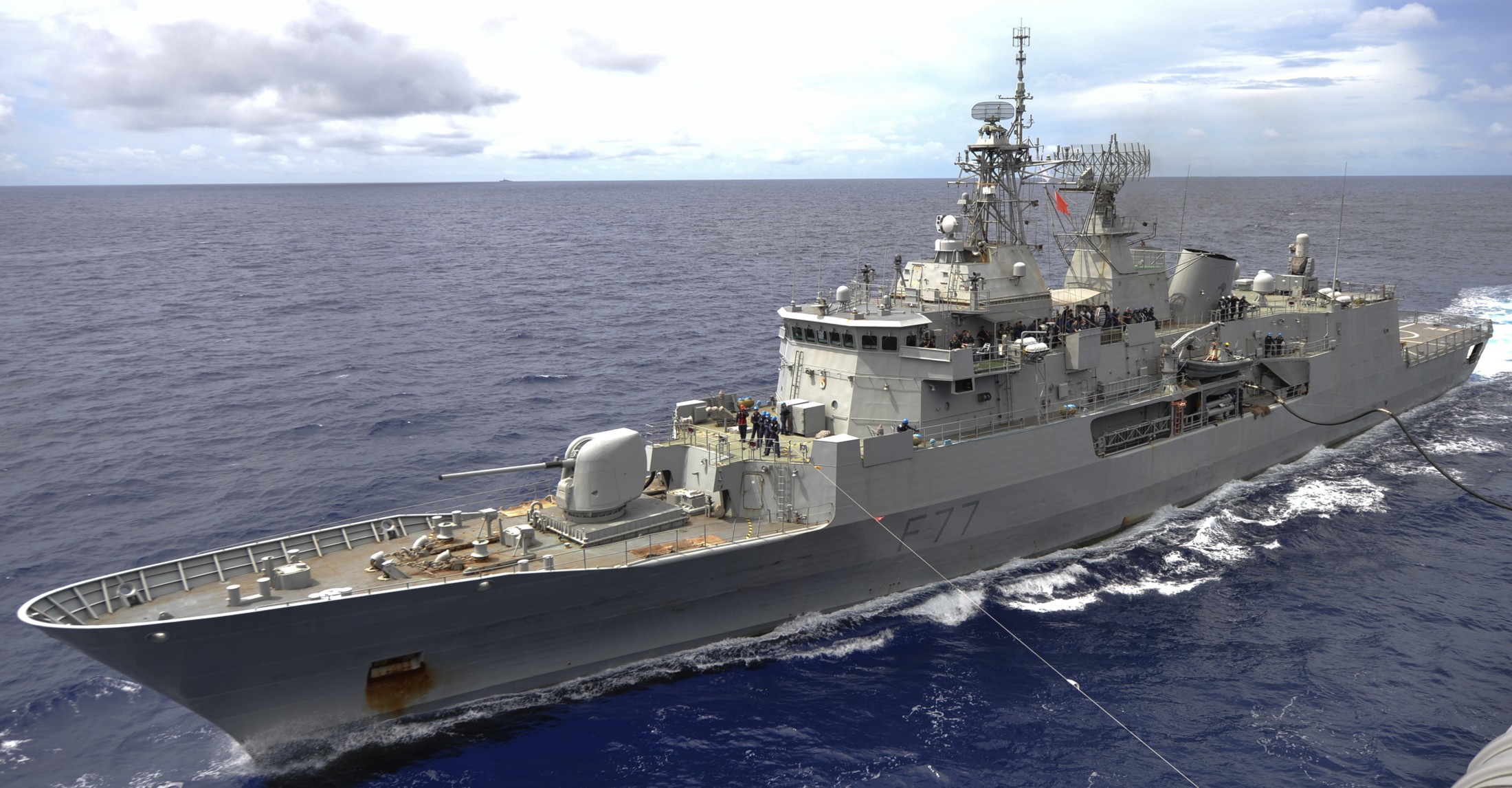 HMNZS Te Kaha (F 77) 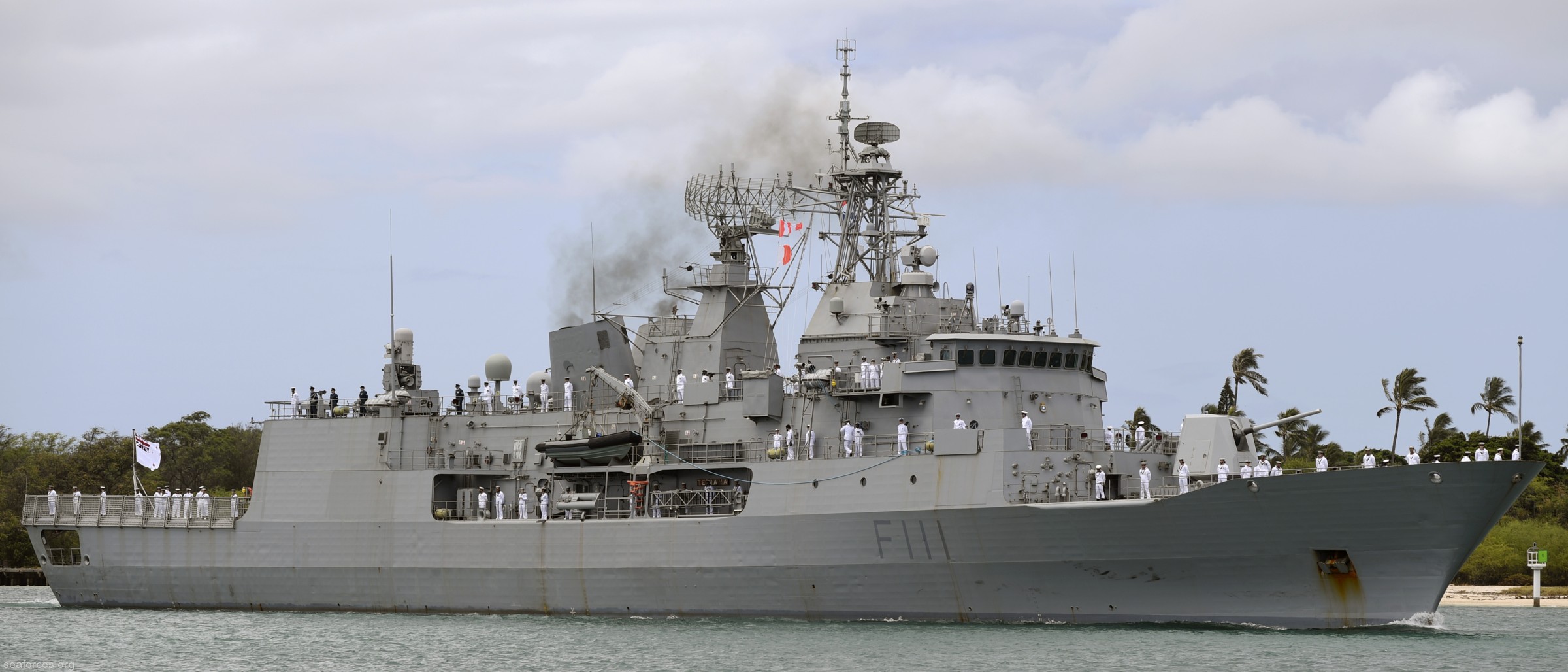 HMNZS Te Mana (F 111) ARMAMENT + DETAILS 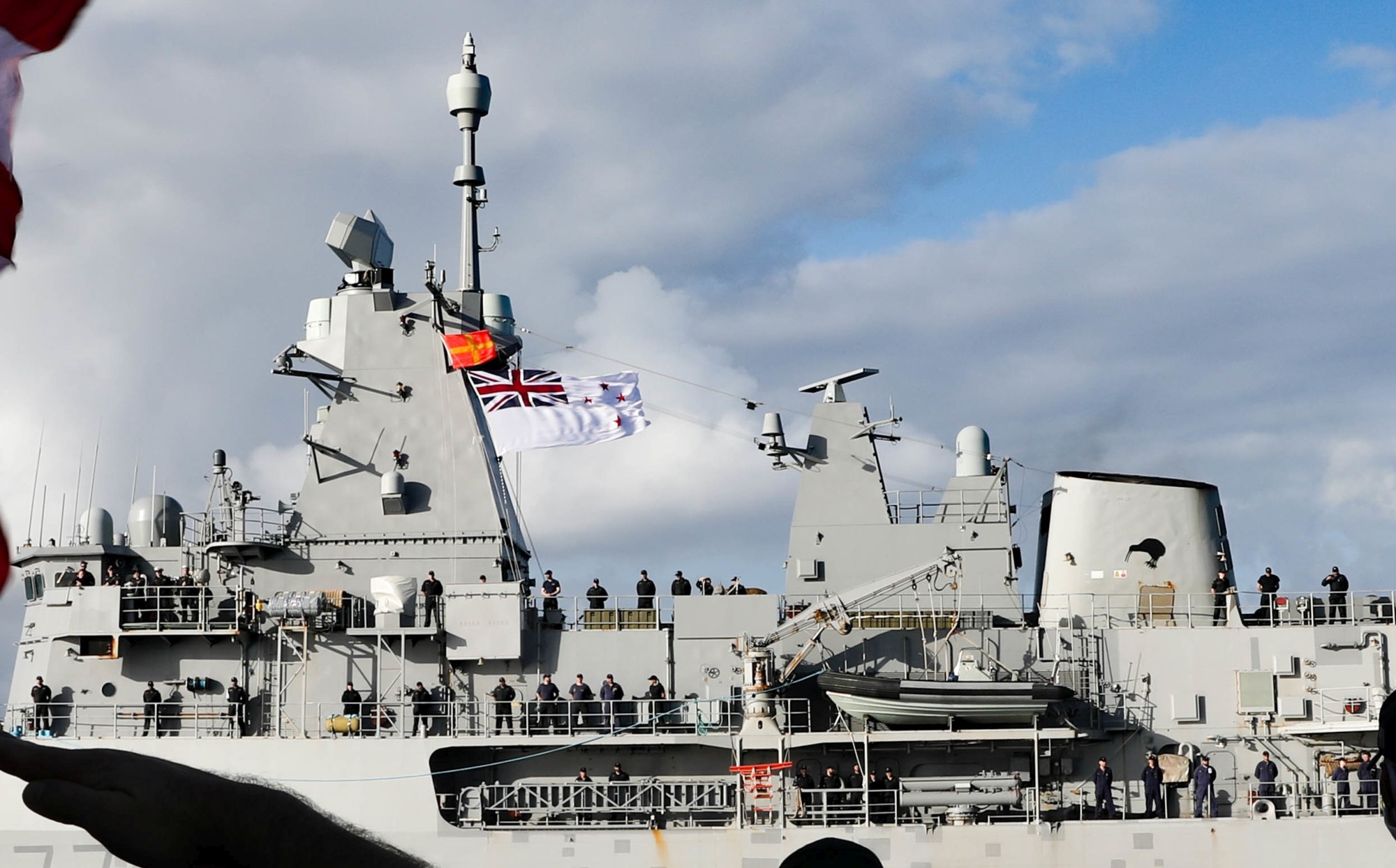 after refit with Thales SMART-S Mk.2 3D radar 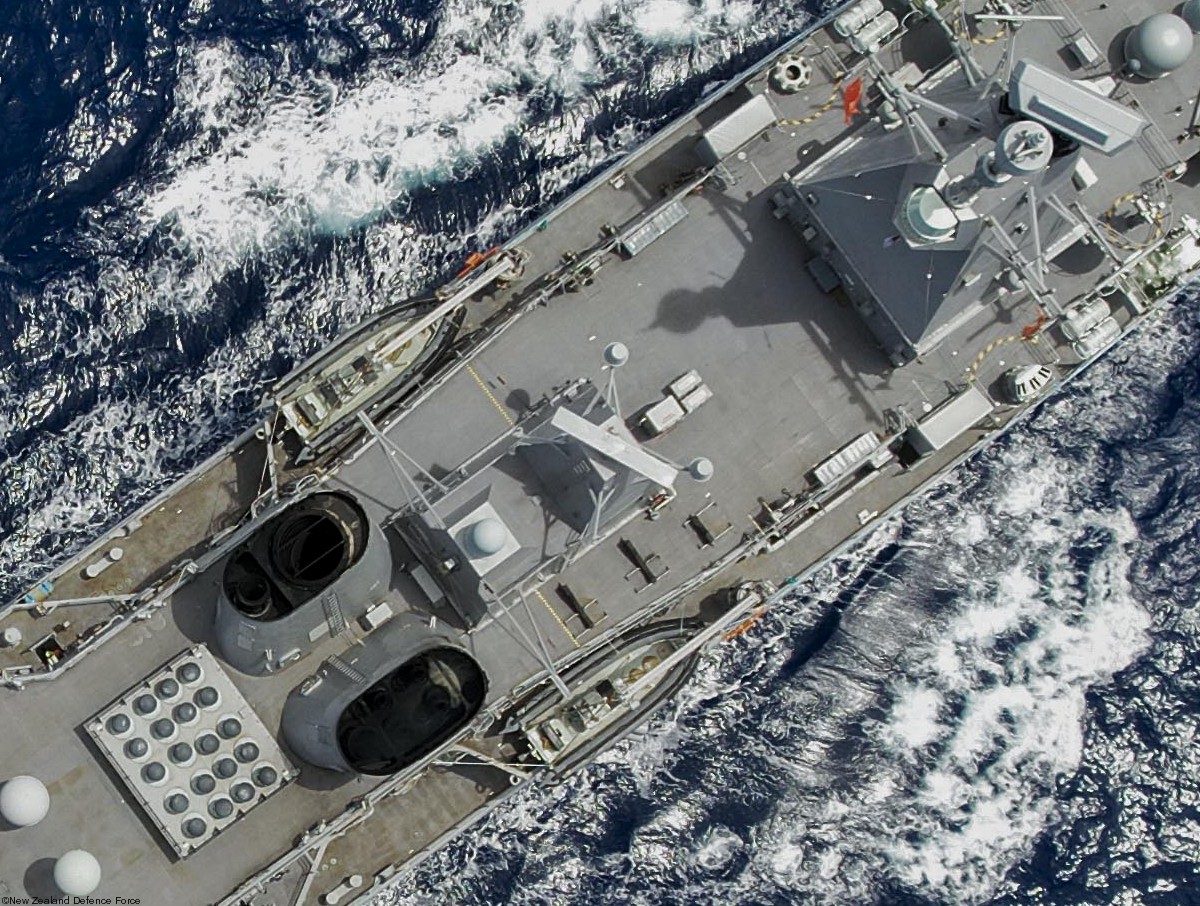 after refit with 20-cell GWS-35 Sea Ceptor vertical launching system for CAMM missiles 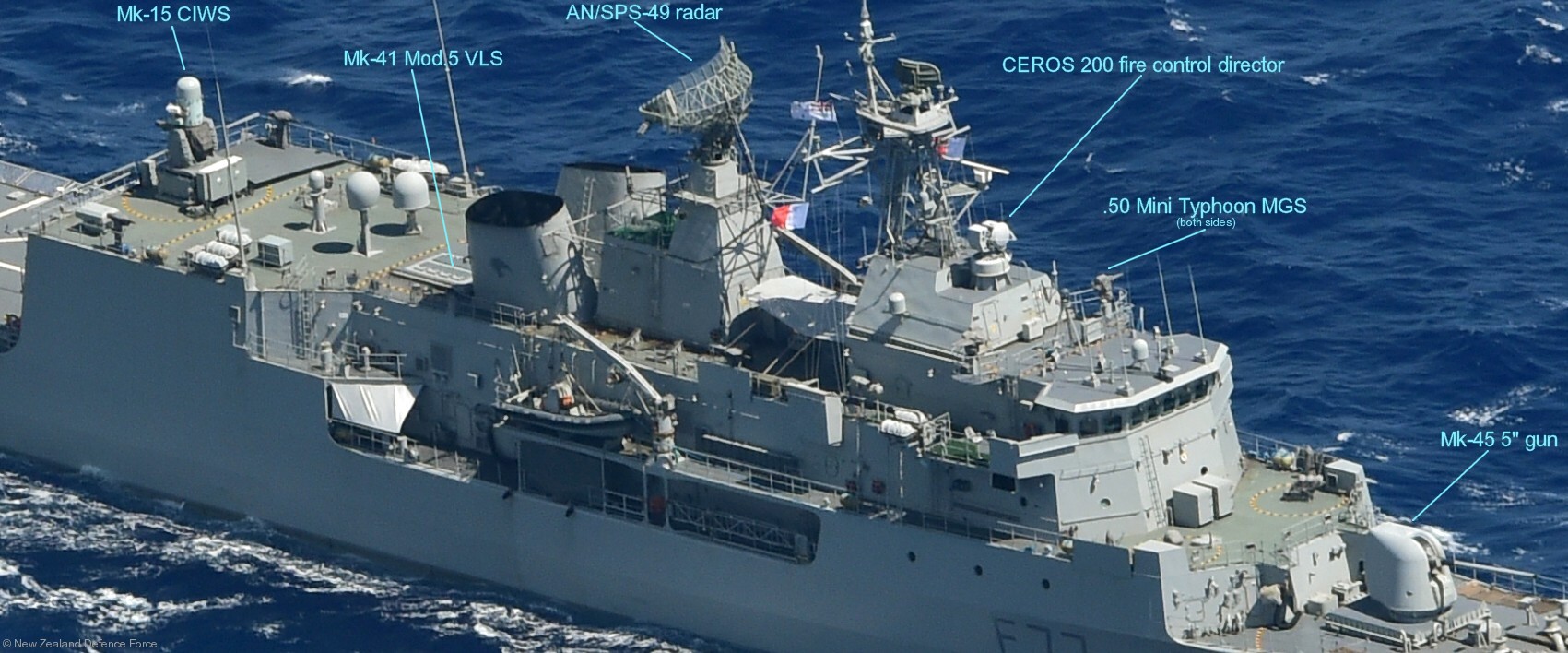 main armament & systems 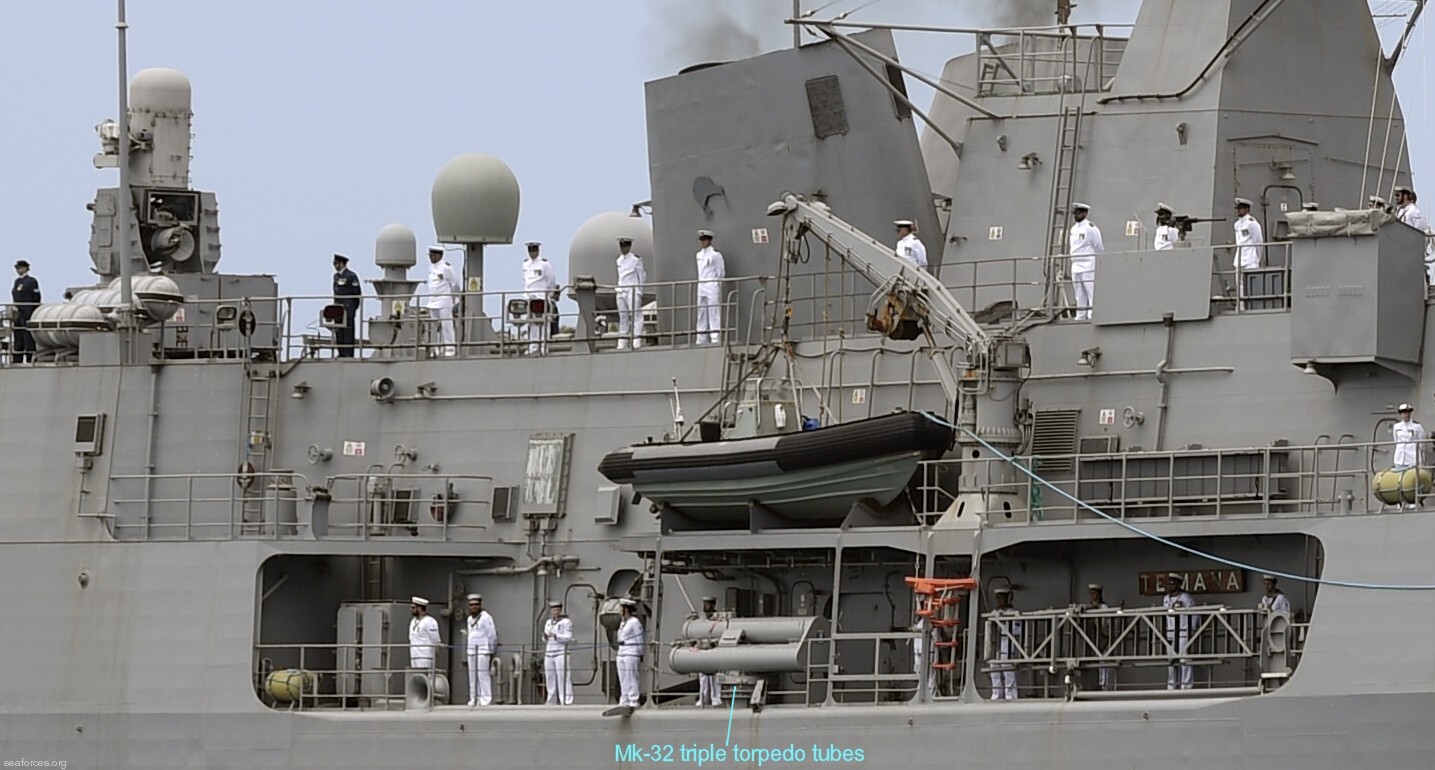 details 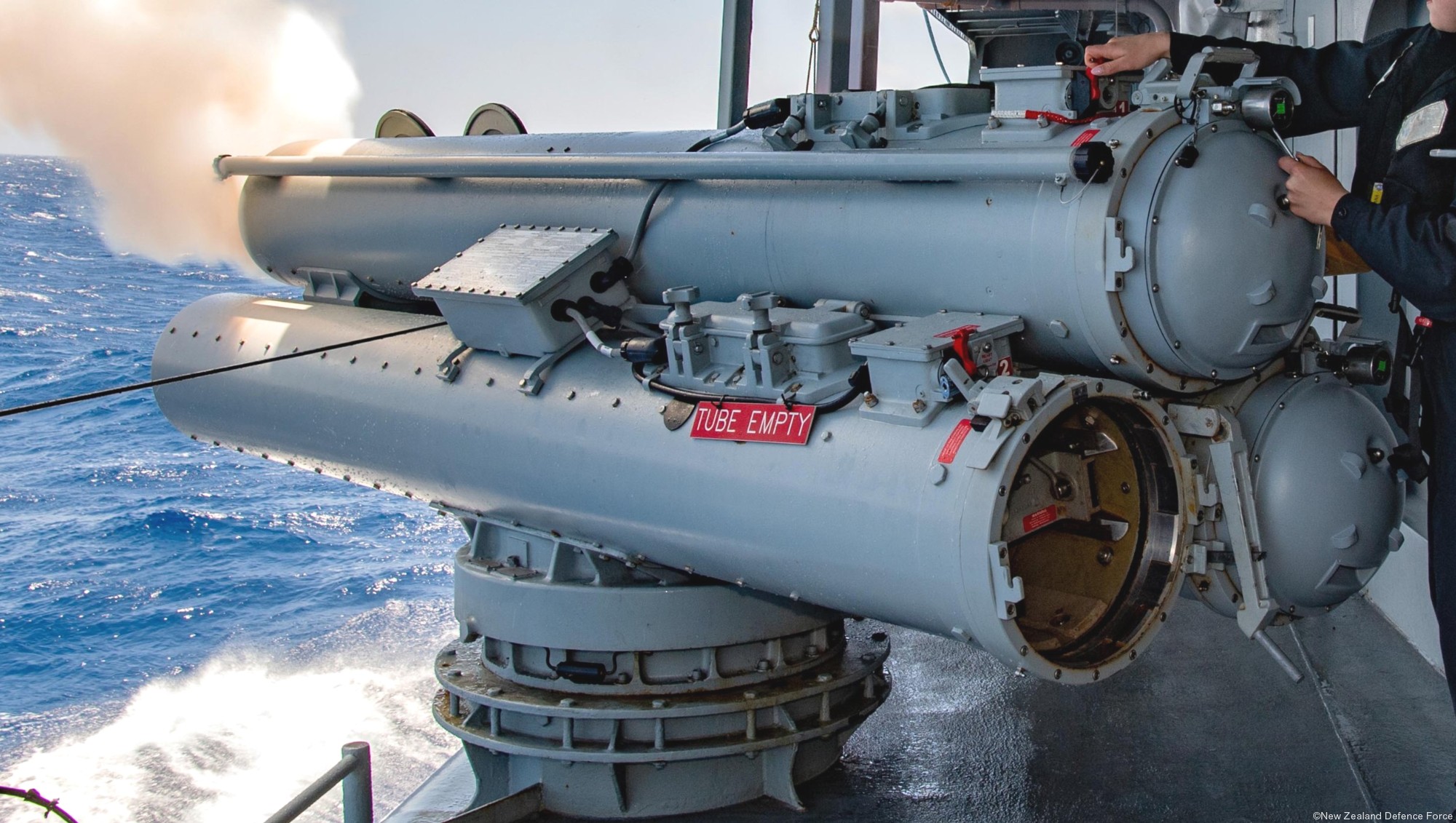 Mk.32 triple torpedo tubes 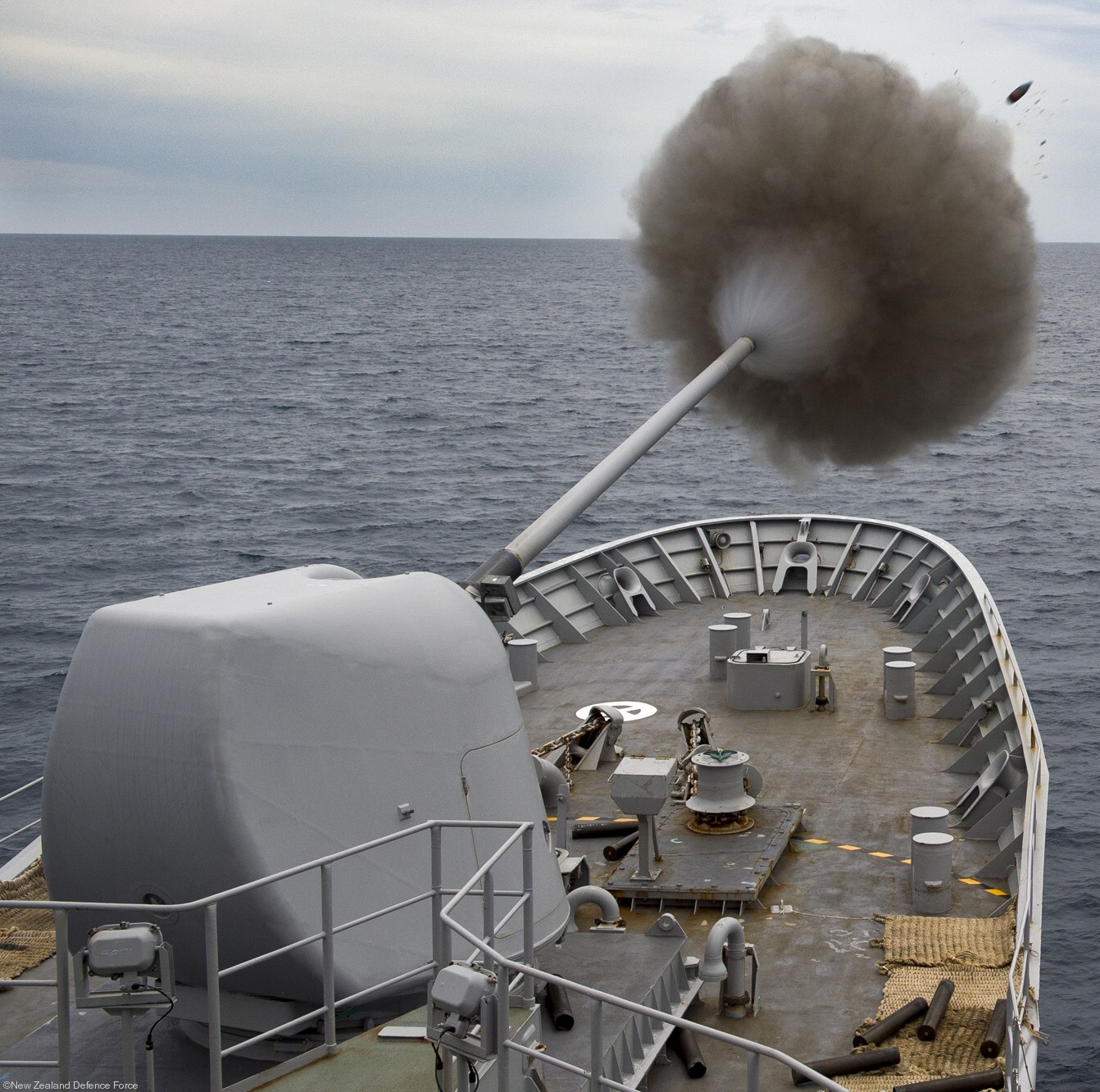 Mk.45 Mod.2 gun 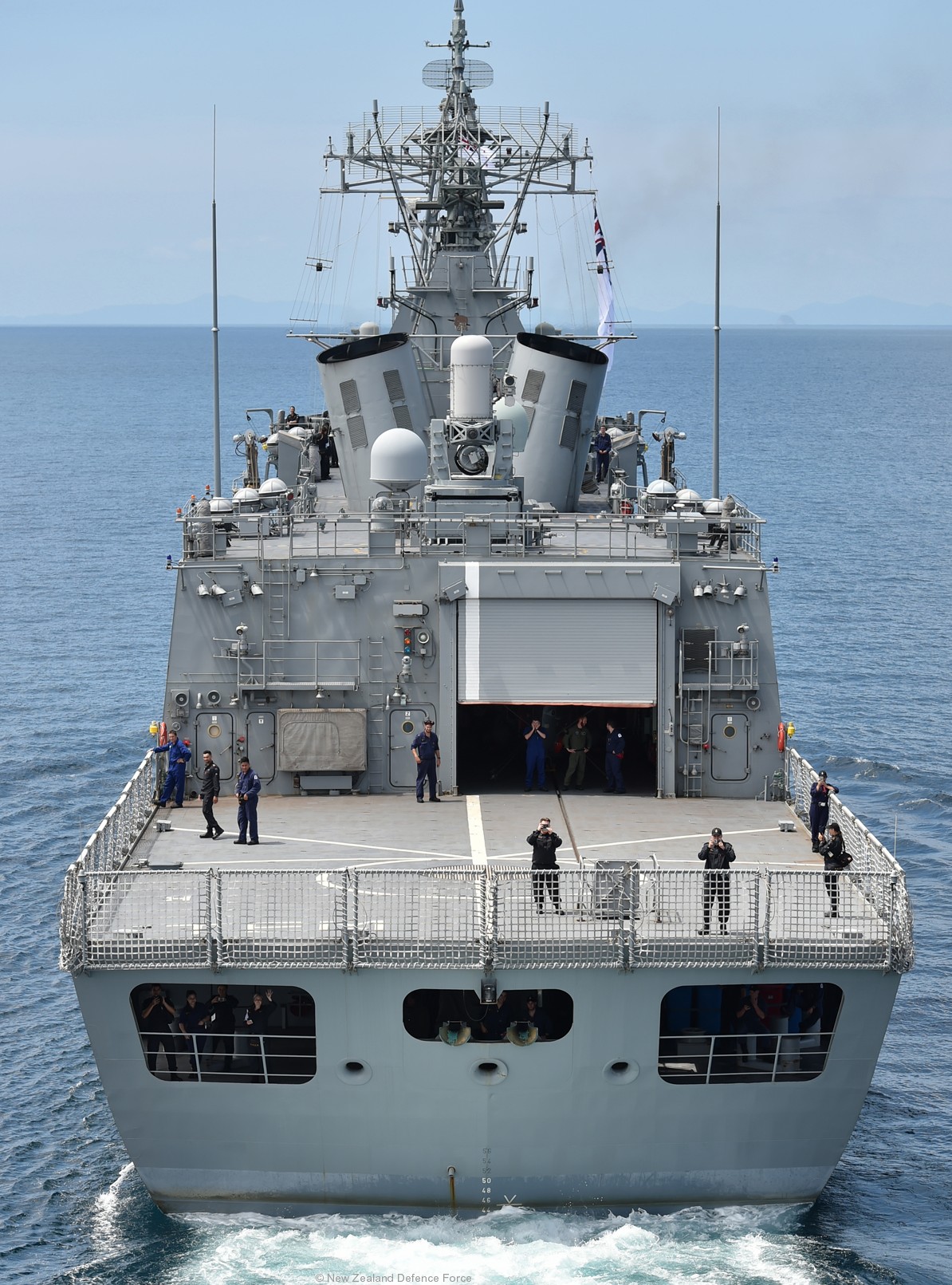 fligth deck, hangar + Mk-15 CIWS 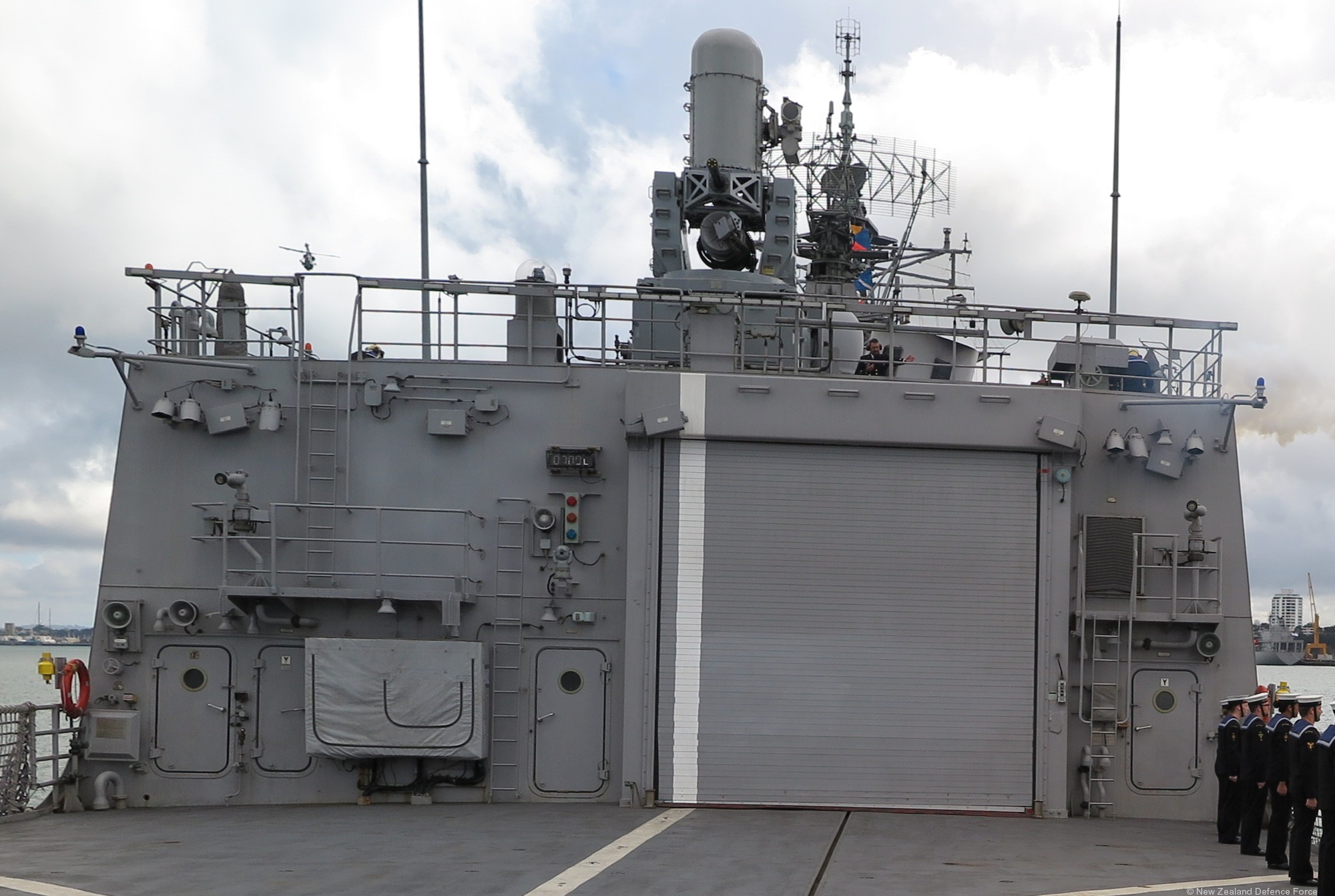 |
|
|
seaforces.org
|
Royal
New Zealand
Navy start page
| |
